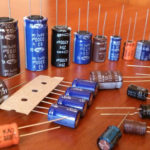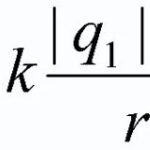Wimshurst generator or electrophore machine is an induction electrostatic device designed as a continuous source of electrical energy. In the 21st century, it is used as an auxiliary technique for demonstrating physical experiments related to various electrical effects and phenomena.
Content
A bit of the history of the invention
In 1865, the experimental physicist from Germany, August Tepler, developed the final drawings of the electrophore machine. At the same time, the second independent discovery of such a unit was made by the German scientist Wilhelm Holz. The main difference of the device was the ability to obtain greater power and potential difference. Holtz is considered the creator of a source of direct electric current.


The simple initial design of the electrophore machine was improved in 1883 by James Wimshurst of England.Its modification is used in all physical laboratories for a visual demonstration of experiments.
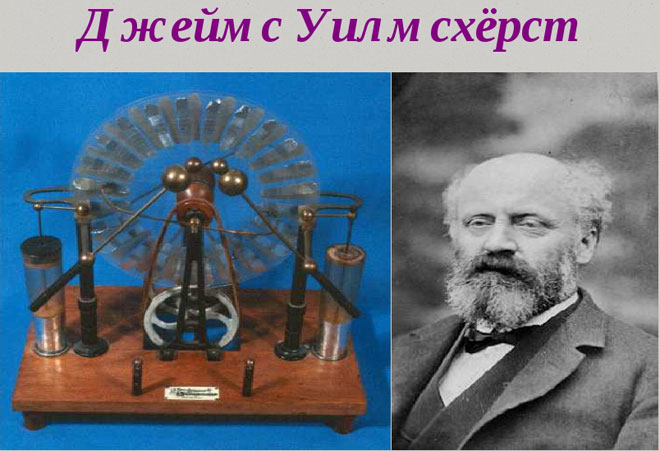
The design of the electrophore machine
2 coaxial disks rotate against each other, while carrying the simplest capacitors from aluminum sectors. Due to random processes, at the primary moment, a charge is formed on the site of one of the segments. The phenomenon is caused by the process of friction against air. Due to the symmetry of the design, it is impossible to predict the final sign in advance.
The design uses 2 Leyden jars. They create a single system from series-connected capacitors. This has the effect of doubling the operating voltage requirements in each tank. It is necessary to select the same ratings, this is the key to a uniform distribution of the operating voltage.
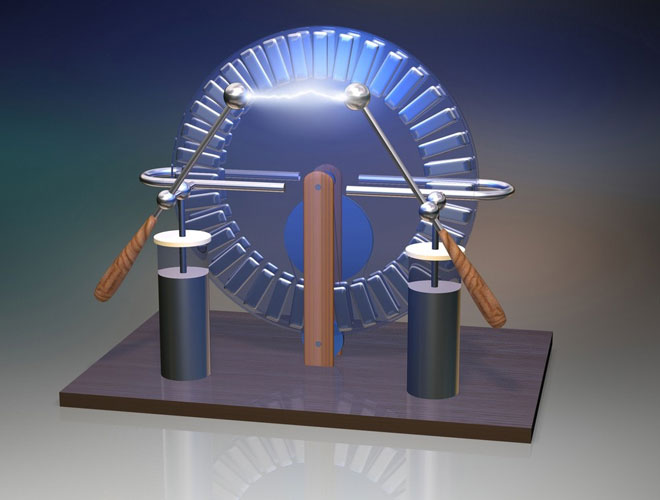
Inductive neutralizers are designed to relieve voltage. The whole structure resembles a metal comb hovering at some distance above the disk. Both disks with equivalent signs of the outer surface come to the charge removal point. Neutralizers are paired. After unloading, the charge of the segments is greatly reduced. In additional designs, the brush easily comes into contact with the edge of the disc.
The operator, using the power of the electric drive or with his own hand, forcibly brings the repulsive elements of the system together. The charges interacting with each other try to settle down as far as possible. The process contributes to a sharp increase in the surface charge density at all removal points.
Electricity is collected in Leiden jars from the crests of neutralizers. There is a rapid rise in voltage.A spark gap attached to 2 electrodes helps to avoid failure of the system. It is possible to obtain an arc of different strength by adjusting the distance between them. There is a relationship: the stronger the field strength between the 2 spark gaps, the more noisy the effect accompanies the process of emptying the Leiden jars.

The segments remain empty past the charge removal point. Downstream, potential equalizers or neutralizers are installed according to the principle of operation. Each opposite side of the disc has already given charge to different brushes. At the moment of passing through the pickup point and after it, the residual charge signs are different.
A piece of thick copper wire with brushes of the thinnest wires hovering at a low height or rubbing segments contributes to the closure of these opposites. The result - the charges on both segments are equal to zero, all the energy is converted according to the Joule-Lenz law into heat generated on the thickened copper core.
What are banks of Leiden
The first electrical capacitor created by Dutch scientists Pieter van Muschenbroek was a Leyden jar. The invented capacitor has the shape of a cylinder with a wide or medium neck of different diameters. The Leyden jar is made of glass. From inside and outside it is pasted over with special sheet tin. The product is covered with a wooden lid. The main function of the invention is the accumulation and storage of large charges.
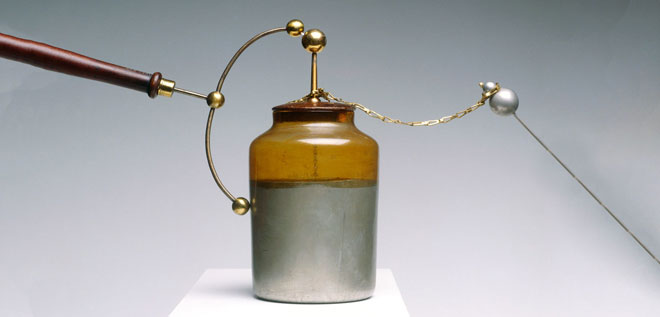
The creation of such a bank was stimulated by a wide study of electricity, the general speed of its distribution, as well as the electrical conductivity properties of various materials. Thanks to her, it was possible for the first time to produce an electric spark artificially.Now Leiden cans are used only as an integral part of electrophore machines.
What is the working principle of the electrophore machine
From the strength of the operator, energy is taken to change signs. Already between equalizers and brushes, the discs move with mutual repulsion towards each other. The number of revolutions per minute plays a role. Increased charge density. The strongest charge of the opposing disks pushes the residues through the pieces of copper wire. From this follows the energy sufficient to change the sign.
By increasing the surface density, the charge is removed from the device. At a single point, energy reserves are made in the Leiden bank, another place serves to change the sign. Induction neutralizers have practically no differences. They both perform a common function of neutralizing energy. General scheme:
- There are 2 types of capacitors in the design: Leiden banks where the charge accumulates, and a combination of a segment of both disks with a dielectric and an aluminum lining.
- There are 2 types of neutralizers that reduce the charge of aluminum segments. The first is used to change the sign or polarization, the second to charge the Leyden jar.
All energy does not come from the friction of aluminum and copper or the electrification of air. It is created by forcibly filling the capacitors with the force of disk torsion. All processes are carried out due to a sharp increase in the surface charge density at the removal points.
Application of Electrophore Machine
From the 70s. the Wimshurst machine is not used for the direct production of electrical energy.Today it acts as a historical exhibit illustrating the history of the emergence and development of scientific and technological progress and engineering. A laboratory demonstration, for which an electrophore machine is created, shows the various phenomena and effects of electricity.
It is acceptable to use induction neutralizers, removing charges from liquid dielectrics, such as oil. It is dangerous to get a spark in the air in any production, it can lead to disastrous consequences, smoke and even an explosion.
The history of discoveries and research in the field of electricity is closely related to the use of various structures and devices for obtaining electric charges. The electrophore machine played its role in scientific research, the action of which is based on the excitation of electricity due to induction.
Similar articles:

